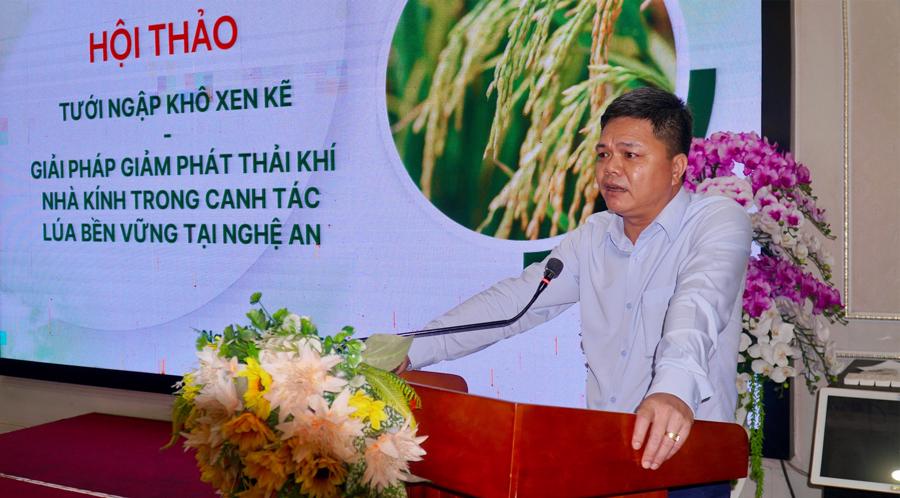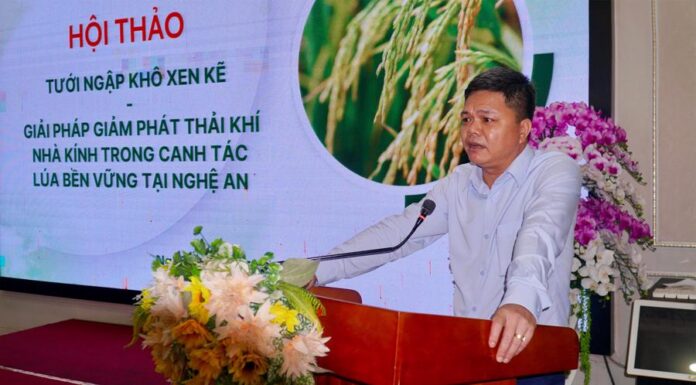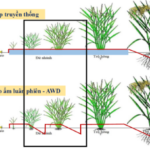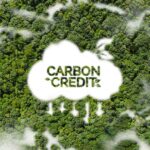The recent workshop hosted by the Nghe An Department of Agriculture and Environment in Vinh city showcased the positive results and vast potential of water-saving irrigation practices in green agriculture. The workshop, titled “Alternate Wetting and Drying – A Solution to Reduce Greenhouse Gas Emissions in Sustainable Rice Cultivation,” highlighted an innovative model that promises environmental and economic benefits.
The pilot project, “Alternate Wetting and Drying – A Solution to Reduce Greenhouse Gas Emissions in Sustainable Rice Cultivation,” was initiated in the spring of 2024 across five districts: Nam Dan, Nghi Loc, Hung Nguyen, Dien Chau, and Do Luong, covering a total area of 5,713 hectares. In just one year, the project expanded to an additional two districts, Thanh Chuong and Quynh Luu, bringing the total cultivation area under this method to 20,029 hectares—nearly four times the initial size.
This rapid expansion reflects the strong support and acceptance of the new farming model by local farmers and authorities. Experts from the Institute of Agricultural Sciences and Technology of North Central Vietnam evaluated and confirmed the significant practical effects of the alternate wetting and drying technique on both the environment and economic fronts.
REDUCING GREENHOUSE GAS EMISSIONS BY OVER 50% AND CREATING NEW INCOME STREAMS THROUGH CARBON CREDITS
The project has achieved impressive results, recording a reduction of greenhouse gas emissions by over 50% compared to the traditional continuous flood irrigation method. This remarkable figure underscores the environmental advantages of the model.
Additionally, this farming practice conserves irrigation water, reduces pumping costs, and minimizes pest and disease incidence, leading to lower usage of pesticides. Notably, average rice yields showed a slight increase, and farmers now have the opportunity to boost their income by selling carbon credits, a novel approach in modern agriculture.

Green Carbon Japan Vietnam, the company implementing the project in Nghe An, has begun the process of establishing carbon credits for the reduced emissions from the rice fields, which will provide a potential additional income stream for farmers in the near future.
Beyond environmental benefits, the model also contributes to building a new value chain for the rice industry in Nghe An. Green Carbon Japan Vietnam has partnered with TH Rice to purchase rice produced using the alternate wetting and drying irrigation method and is working towards developing a low-emission rice brand that meets international standards and targets export markets.
Mr. Phan Tien Thanh, representing Green Carbon Japan Vietnam, stated that rice produced through this process would undergo stringent checks for pesticide residues and meet the quality standards for export to premium markets.
The model is expected to increase farmers’ income by approximately 10% through higher and more stable rice prices, secured by long-term consumption contracts.
TRANSFORMING FARMING PRACTICES, EXPANDING AREAS, AND EMBRACING SUSTAINABLE AGRICULTURE
In addition to environmental and economic benefits, the alternate wetting and drying irrigation model brings about a shift in traditional farming practices. By changing the irrigation method, the model enhances field ecology diversity, improves soil quality, and preserves rice production resources over the long term.
Mr. Vu Duy Hoang, Deputy Director of the Center for Organic Agriculture under the Vietnam Academy of Agricultural Sciences, emphasized, “The successful large-scale implementation of the project demonstrates the superiority of the alternate wetting and drying technique. This lays the groundwork for further expansion toward environmentally friendly and sustainable agriculture.”
Associate Professor Dr. Nguyen Dinh Tho, Deputy Director of the Institute of Strategy and Policy for Agriculture and Rural Development, affirmed that the model is a step in the right direction, aligning with the province’s and nation’s sustainable agricultural development policies in the context of climate change and increasing international integration.
Based on the encouraging results, Nghe An province plans to collaborate with relevant stakeholders to further expand the adoption of alternate wetting and drying irrigation across the province.
Despite the impressive achievements, the workshop also identified challenges that need to be addressed in the next phase, including the lack of synchronization in the irrigation system, water level measurement equipment, and a system to record and report technical parameters in the fields.
Additionally, experts pointed out the need to enhance the awareness and skills of a portion of farmers and local technical staff through communication campaigns and training programs…
Unlocking Emission Reduction Potential: Generating Carbon Credits Through AWD Irrigation Technology in Rice Cultivation
With the potential to expand its agricultural land in a climate-friendly direction, provinces like Nghe An can develop a system to verify emission reductions from alternate wetting and drying (AWD) irrigation technology models. This step-by-step approach establishes a foundation for carbon credit trading in agriculture, paving the way for a green financial mechanism that attracts investment to the sector. It also lays the groundwork for formulating agricultural carbon credit policies.
A National Carbon Market Trial: Potentially “Delayed” from the Initial Plan
To effectively operate a carbon market, one of the crucial issues is standardizing the supply and clearly defining the eligible ‘commodities’ for market circulation.
Why Are Many Businesses Buying Carbon Credits Instead of Reducing Emissions Themselves?
In the midst of a growing global push for Net Zero commitments, the carbon credit market is experiencing a surge in demand from businesses. A prevalent trend sees companies opting to purchase carbon credits as an alternative or supplementary solution, rather than solely focusing on direct emission reductions in their production operations. This development raises questions about the motivations behind these decisions and the potential implications for the trajectory towards achieving net-zero emissions by 2050.





















